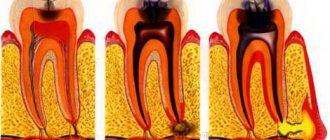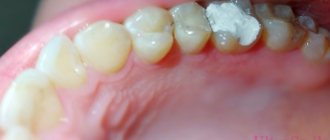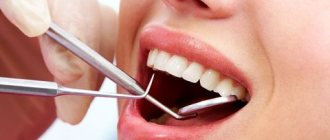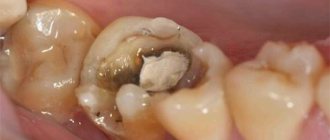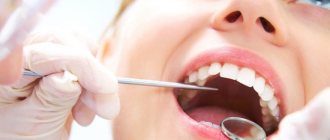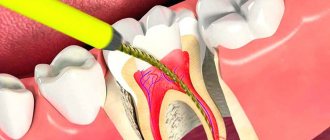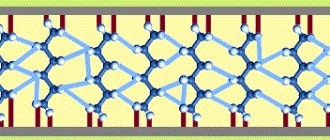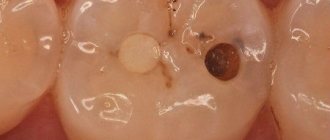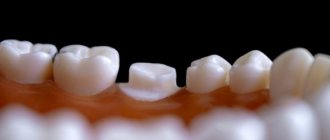It is not always possible to treat a tooth in one visit - if the caries is complicated and the root canals are inflamed, the doctor puts a temporary filling under which he puts medications. It prevents medication from falling out, protects the treated dental cavity from food debris and microbes.
A temporary filling is made of a looser material. It is plastic and does not dissolve in water. For filling, dentin paste, sympath, vinoxol, and zinc-polyacrylate cement are used. The doctor chooses the material, taking into account the diagnosis and the condition of the tooth.
Temporary filling is used for prosthetics, if caries has not reached the nerve, when the nerve is removed. A filling is also installed in the following cases:
- treatment of pulpitis, periodontitis;
- deep caries;
- removal of a tooth root cyst;
- multi-stage therapy;
- making a dental stump inlay when installing a crown.
The period of wearing a temporary filling usually does not exceed 1-1.5 weeks, but sometimes it can be extended up to six months. The dentist determines it exactly.
Sometimes, after installing a temporary filling, patients complain of discomfort and pain. Why does pain occur, how to deal with it?
Why does a tooth hurt after installing a temporary filling?
Pain and discomfort can be a normal reaction, which occurs in 60% of patients, but sometimes pain indicates pathology, inflammation, and complications. After filling, you need to listen to your feelings; if your condition worsens, be sure to consult a doctor.
Installing a temporary filling may cause pain due to treatment and tooth preparation. Natural causes of pain:
- irritation, tooth trauma during cavity treatment, drug installation;
- the effect of medications on the dental pulp;
- the effect of necrotizing agents on the nerve, pulp until the death of nerve endings;
- increased tooth sensitivity, exposure to cold or hot food.
Temporary pain occurs in the first few days after treatment, it is short-lived, the intensity of the sensation gradually decreases, the tooth “aches”, but without excessively painful sensations. How long a tooth hurts after installing a temporary filling depends on the disease: during the treatment of caries it may not appear, but with pulpitis it goes away within one to two weeks. Dental gels and special pastes that reduce tooth sensitivity will help alleviate the condition.
Sometimes, under a temporary filling, severe tearing pain occurs, which intensifies at night. If such sensations are accompanied by other symptoms - swelling of the cheek or gums, numbness of the jaw, increased temperature, this indicates the development of complications. In this case, you need to consult a doctor as soon as possible.
Symptoms
After filling teeth, an unpleasant bitter taste and even a burning sensation may appear in the mouth. Sometimes the taste and smell of the medicine can be felt not only by the person himself, but also by the people around him. As a result, self-doubt and problems communicating with other people are added to the main problem. Unpleasant sensations in the mouth significantly impair the quality of life. People with an increased gag reflex cannot even drink or eat.
Many people are afraid of this situation due to the fear that the installed filling is leaking and leaking the medicine that is under it.
But this is an erroneous opinion and has no basis. Therefore, before you give in to panic, you need to figure out why the problem appeared and take measures to eliminate it.
Temporary filling always leaves a taste in the mouth
Possible complications after installing a temporary filling
Pathological processes or complications during treatment can arise due to an allergic reaction of the body, an incorrectly chosen treatment strategy, non-compliance with the period of wearing a temporary filling, or due to loss of medication.
- If the installation of a temporary filling was carried out after placing the drug in the tooth canal, pain may be a sign of an allergy, incorrect dosage of the drug, or incorrectly selected time of exposure. In case of allergies, the doctor replaces the cementing composition or medication.
- If the filling hurts when pressed, this indicates that the periodontal tissue is damaged.
- “Shooting” sharp pain is a sign of purulent pulpitis or tissue inflammation.
- If the pain occurs upon touching and is acute, there may be a piece of dental instrument left in the root canal. The cause of such sensations is also periodontitis.
- Night pain occurs with pulpitis.
Installation of a temporary filling is one of the stages of treatment, and not full-fledged therapy. Over time, such filling material falls out, food and microbes enter the tooth cavity, which leads to a worsening of the condition and the development of complications. In advanced cases, incomplete therapy can cause tooth loss.
How to get rid of bad breath
Some sensitive issues are not usually discussed even with close relatives. People tend to turn a blind eye and ignore them for a long time, especially if the solution requires consulting a specialist. In such a situation, many choose the path of least resistance - folk recipes and various remedies that can be used at home. As a rule, they are ineffective, but such a choice does not require much effort and suits the person until the problems reach frightening proportions.
The scenario described above is more than typical for the symptom discussed in this publication. Bad breath is not something to discuss. The rules of good manners do not allow others to point out the problem, and the person himself prefers to think that it is not so big.
In everyday life, this symptom of chronic somatic diseases or dental pathology is often described with the vague formulation “bad breath.” Doctors and dentists use the more correct and unambiguous term “halitosis.” Breath with a “smell” most often indicates the development of certain diseases. It is not necessary to discuss the situation with loved ones, but if bad breath appears, it is extremely important to undergo a diagnosis that will reveal the true causes of halitosis.
Causes
Not all causes of halitosis are a cause for concern. In a certain percentage of cases, it’s all about the banal consumption of certain foods or drinks that have pronounced aromatic properties. An example would be garlic, onions or fish - foods with a specific aroma. Exogenous causes include smoking. Tobacco often causes bad breath, which the smoker himself does not even notice. But these reasons are obvious, and it’s easy to fight them. It is more difficult (and more important!) to solve a problem that has no obvious causes.
In order to get rid of bad breath once and for all, which has been bothering you for a long time and is not associated with exogenous causes, it is important to find out what causes its appearance. Endogenous (internal) causes can be divided into two categories.
The first category is diseases of the oral cavity. It is oral disease that is the root of the problem in the vast majority of people with halitosis. Dental diseases that can lead to bad breath are discussed in more detail in the next section of the publication.
The second group of causes is formed by chronic diseases of the stomach, other parts and organs of the digestive system, and diseases of the endocrine organs. The greatest danger is diabetes mellitus, both type 1 and type 2. This endocrine pathology is characterized by the appearance of an “acetone” odor. It is caused by metabolic disorders: the patient’s body increases the formation of ketone bodies (organic compounds), which are excreted through the lungs and give the breath a specific “acetone” smell.
Parents should be wary of this symptom (smell of acetone). If a child develops a symptom, you should immediately consult a specialist and undergo an examination, a mandatory element of which is a glucose tolerance test and a blood sugar test.
Note that in rare cases, the unpleasant odor of acetone is associated with dietary habits. In recent years, the so-called ketone diet, which requires maximum restriction of carbohydrate intake, has become very popular. Its goal is to transition the body into a state of acidosis, in which there is an increased formation of ketone bodies. Because these organic substances are partially eliminated through the lungs, followers of the ketone diet often face the problem of bad breath.
Halitosis in dental pathology
Gastrointestinal diseases (gastritis, stomach ulcers), diabetes mellitus or the ketone diet are conditions that people are generally well aware of. The only exception is undiagnosed diabetes, so if the smell of acetone appears, it is extremely important to promptly seek qualified help.
If bad breath appears against the background of “complete well-being,” its causes should be sought in dental pathology. It is very important to understand that oral diseases are the main causes of halitosis in people without chronic endocrine or somatic pathology. If you are interested in the question of how to get rid of bad breath, carefully study this section of the publication. This way you can avoid common mistakes, forget about the problem forever and, most importantly, keep your teeth intact and healthy.
In diseases of the oral cavity (often they are not diagnosed, that is, the person may not be aware of the problem), the unpleasant odor has a specific, slightly “putrid” character. At first, a person notices the symptom, mainly after sleep, before carrying out morning hygiene procedures. Then the problem of bad breath becomes a constant companion, which causes serious concern.
Caries
What diseases provoke the appearance of halitosis? In the first place is caries. Carious tooth damage is accompanied by the development of pathogenic microflora. Bacteria produce toxins that cause inflammation in the oral cavity. In addition, bacteria emit gaseous substances, which themselves have an unpleasant odor.
The degree of carious lesion directly affects the severity of halitosis. The deeper the microorganisms penetrate into the tooth, the stronger the unpleasant odor. The problem can only be solved by complete removal of the affected tissue with restoration of the defective tooth.
The only right decision is to seek help from a specialist without any extra thought or doubt. Make an appointment with your dentist, otherwise the tooth will continue to decay. Once a critical amount of living tissue has been destroyed, restoring the tooth will require expensive orthopedic treatment.
Periodontitis, fistula in the gum
Purulent inflammation around the root apex is the result of untreated caries and pulpitis. An apical abscess can manifest itself as a symptom such as the formation of a fistula on the gum. A fistula is the external opening of a canal connecting a cyst to the oral cavity. Through the fistula, pus is released, which is accompanied by the appearance of a characteristic unpleasant odor.
Poor hygiene
Are there other causes of halitosis besides tooth decay? Undoubtedly. Bad breath can be the result of poor oral care. If a person brushes their teeth sporadically, or does it too quickly or not thoroughly enough, a bacterial film forms on the surface of the teeth. Over time, this soft film, which can be easily removed with a regular brush, becomes saturated with mineral salts. This forms hard stone on the teeth, which can no longer be removed with a brush.
The basis of dental plaque is bacteria, which release toxins and gaseous substances, causing inflammation of the oral mucosa. Due to these processes, the breath acquires an unpleasant odor.
Gingivitis, periodontitis
Hard dental plaque is a harbinger of dental caries and a number of other oral diseases. If you do nothing, sooner or later you will face more serious problems than halitosis. Many people begin to notice that their gums bleed during daily brushing. These are the first symptoms of gingivitis, in which an inflammatory process develops in the gum mucosa.
Gingivitis left untreated (or treated with home remedies that are ineffective) leads to the development of periodontitis, an oral disease that poses a real risk of tooth loss. At this point, many remember that it all started with poor hygiene and bad breath, and the problem was easily solved by hygienic teeth cleaning in the dental office.
How to get rid of bad breath?
Even today, in the age of maximum availability of information about various symptoms, their causes and treatment methods, many people continue to pose the question differently: how to get rid of bad breath at home? Is this possible, and if not, why?
Fresh breath, which is actively advertised by manufacturers of toothpastes and chewing gums, is an indicator of good hygiene and overall health of the oral cavity and teeth. Breathing is a kind of litmus test that allows us to understand how healthy we are and how attentive we are to personal hygiene.
Bad breath is a red flag and an indicator of serious problems. Problems not only with hygiene, but with oral health. It is possible to mask halitosis by chewing gum or regularly rinsing the mouth with special solutions, but this will not solve the problem.
How to eliminate bad breath if it is caused by stone formation with activation of pathogenic microflora? Stone is a mineralized plaque that is firmly fixed to the enamel. It is not possible to remove the stone yourself. This can only be done by a dentist using special equipment. Ultrasonic cleaning is used to remove tartar. Another technology for removing deposits is Air Flow.
Professional teeth cleaning is the most effective means of preventing caries, periodontitis, gingivitis and other dental diseases!
For gingivitis, professional teeth cleaning to remove hard deposits is also a mandatory stage of treatment. After cleaning the teeth, anti-inflammatory therapy is prescribed for 10 days. The patient should rinse the mouth with antiseptic solutions several times a day. After rinsing, special dental gels with an anti-inflammatory effect are applied to the gums.
In case of periodontitis, the above stages of treatment do not lose their relevance, but teeth cleaning is complicated by the fact that it is necessary to remove stone from periodontal pockets. This is difficult to do; the treatment is carried out by a doctor with a narrow specialization - a periodontist. In addition to anti-inflammatory drugs, antibiotics are often prescribed.
How to remove bad breath caused by caries? If the cause of “stale breath” is caries, there is no need to talk about the effectiveness of any methods for use at home. Science has not yet known cases of self-healing from this disease. The person who finds a way to cure tooth decay without the help of a dentist should be awarded a Nobel Prize.
Caries treatment is carried out in a dental clinic. The dentist removes all tissues affected by the carious process. If this is not done, a source of infection will remain, which will lead to further decay and destruction of the tooth.
After removing the carious defect, the tooth is restored with a composite polymer (a filling is placed). If caries is complicated by the development of pulpitis or periodontitis, the stage of depulpation, sanitation and subsequent sealing of the canals is added to the treatment protocols. Depulpation with root canal sealing increases the duration and cost of treatment, but it is necessary if you want to save the tooth.
To cure caries quickly and without extra costs, contact your dentist when the first symptoms appear, or better yet, schedule a consultation every six months for a preventive examination and professional teeth cleaning.
Bad breath after caries treatment
Some patients develop bad breath after caries treatment. As a rule, bad breath is accompanied by another symptom - local pain in the area of the projection of the treated tooth or the formation of a fistula in the gum. The condition should be considered as a complication that indicates poor quality dental care.
The cause of post-filling pain is the re-development of the infectious process in the deep tissues. This is caused by incomplete removal of carious tissues or poor isolation of the tooth during filling or sealing of canals. In the first case, pathogenic microorganisms remain in the tooth, in the second, saliva and bacteria get under the filling, which become a source of secondary infection.
To remove bad breath in such a situation, you need to undergo repeated treatment with unfilling of the root canals and sanitization of the source of infection. To avoid complications, contact dental centers with a good reputation and trust your oral health to qualified, conscientious and experienced specialists.
Prevention
If there is no unpleasant odor, its occurrence can be easily prevented. High-quality and regular cleaning of the oral cavity is enough. After eating, it is important to remove the smallest particles of food from the interdental spaces. To do this, you need to use dental floss, and then clean the lingual and outer surfaces of the teeth with a good brush, preferably with stiff bristles.
People with orthopedic (crowns, bridges) or orthodontic (braces) structures, as well as anomalies in the location of teeth in the form of crowding, may require additional tools for personal hygiene. Dentists strongly recommend that such patients purchase an irrigator with special attachments that ideally cleans crowns, braces, narrow interdental spaces and gum pockets.
It is good practice to have your teeth professionally cleaned with Air Flow regularly at your dentist's office to help prevent plaque from forming. Once every six months you need to make an appointment for preventive examinations with a dentist to detect caries at an early stage.
To receive individual recommendations regarding solving the problem of “stale breath,” sign up for a consultation with a medical dentist (Moscow).
What to do if your tooth hurts
Discomfort and pain in the first days after the procedure are normal. If pain persists, you should consult a doctor. He will perform diagnostics and give recommendations.
If it is impossible to see a dentist, the following measures will help alleviate the condition:
- taking analgesics - Ketorola, Naiza, Analgin: these medications will relieve pain;
- rinsing the mouth with herbal infusions based on chamomile, sage, eucalyptus: the plant material is poured with boiling water, left for about an hour, cooled and filtered;
- rinsing the mouth with a solution of soda and salt;
- you can make a lotion from valerian infusion: soak a cotton swab in the infusion, apply to the gum next to the damaged area;
- if swelling has developed as a result of inflammation, antihistamines will help reduce it;
- Gels containing painkillers will help eliminate discomfort.
Important: these are temporary measures designed to alleviate the condition, and not an alternative to going to the doctor. Visit your dentist as soon as possible!
What are temporary fillings?
A temporary filling is created from a special material that does not dissolve in water. The composition of the filling substance and the material for its creation must be selected individually - it all depends on the patient’s diagnosis, as well as on the type and degree of damage to the patient’s tooth.
- Caries under filling
Dentine paste
This material is able to protect the tooth surface from staining with amalgams. It also has the property of repelling moisture, so this material is not used together with liquid medications. It hardens in about two hours, and you can wear such a filling from one week to ten days.
Dentine paste
Vinoxol
This material is very durable, which is why the integrity of such a filling can be maintained for up to six months. This material has antiseptic properties, so such fillings are placed if the cavity of the affected tooth needs to be disinfected. Hardens in about four hours.
Artificial dentin
Another name for this material is zinc sulfate cement. It is set for no more than seventy-two hours. Before installing an artificial dentin filling, the tooth cavity must be thoroughly dried so that the filling mass does not have contact with a humid environment: in this case, the material will not be able to harden.
Artificial dentin
Nice
This substance exists in white and pink colors. Such fillings are most often installed for the treatment of non-pulpless teeth. This filling is hypoallergenic and cannot irritate the oral mucosa.
Nice
Polycarboxylate cement
This material has quite high strength. Also, the mass is biocompatible, so such fillings are installed mainly on baby teeth. In addition, the mass is used for fixing dentures.
About polycarboxylate cement
Blend of oxide, zinc and eugenol
This mixture can not only effectively disinfect the patient’s oral cavity, but also have a sedative effect. This material has high resistance to any mechanical loads. Hardening of the mass occurs within twelve hours.
When to see a doctor
If a tooth under a temporary filling constantly hurts, and the pain is bursting in nature and intensifies at night or during the day, you need to consult a dentist as soon as possible. The doctor examines the damaged tooth: if the filling has fallen out, he will put a new one and replace the medication. If the pain is caused by the development of inflammation or infection, the dentist will take action and change the treatment strategy.
You should immediately consult a doctor in the following cases:
- pain is accompanied by a feeling of swelling of soft tissues;
- the gums or cheek turn red, swell, and swelling appears;
- body temperature rises;
- the intensity of pain does not decrease within several days;
- when exposed to high or low temperatures, the pain intensifies;
- signs of general intoxication of the body develop;
- lymph nodes (primarily submandibular) enlarge and become painful on palpation;
- there is an unpleasant odor from the mouth;
- The temporary filling falls out, its tightness is compromised: cracks and chips form in the cementing material.
In such cases, the dentist will open the filling, remove the medicine and any remaining filling material. The doctor will disinfect the hole, clean and dry the root canals. If necessary, seal them with sealer and install a pin. After such treatment, an x-ray is performed - it allows you to evaluate the quality of treatment. Next, the dentist can re-install a temporary filling or change therapeutic methods.
Precautionary measures
To prevent problems after dental treatment and filling, you must follow some rules. Brush your teeth with a soft bristle brush and rinse your mouth after every meal. Try not to put any strain on the treated tooth and chew food on the other side of your mouth. There is no need to test the filling material for strength and put pressure on it. You will also have to temporarily stop eating solid foods (nuts, candies), chewing gum and caramels.
It is important to promptly identify the causes of unpleasant taste in the mouth and eliminate them. This will ensure good dental health and no future dental problems.
Reasons for installing a filling
Installing such a filling allows the dentist to monitor the effectiveness of the therapy. The presence of a filling can be an indicator of whether all affected parts of the tooth have been removed and whether therapy needs to be repeated.
Important ! If, after the period of wearing the filling, the dental therapy has not yet been completed, in this case the doctor is obliged to exchange it for a new one and continue the therapy.
Thanks to a temporary filling, the doctor can control the treatment process
The most common reasons why a temporary filling is installed.
| Cause | Description |
| Therapy for deep caries | Even an experienced doctor in this case cannot be completely sure that all the affected tooth tissues have actually been removed. That is why, to be on the safe side, a specialist installs a temporary filling on the patient in order to later check the effectiveness of treatment and the tooth’s response to therapy, and in the absence of relapse of the disease, install a permanent filling on the tooth. |
| Removal of the nerve located deep in the tooth, or treatment of its inflammation | Inflammation of the nerves of the tooth is called pulpitis. When it occurs, an inflammatory process occurs in the nerve bundle located deep in the tooth. The nerve is necessary to connect the hard tissues of the tooth with the nervous and circulatory systems. If a patient has deep caries, then in the absence of treatment, the nerve of the tooth is also involved in the development of caries. This phenomenon is very dangerous for the patient, and it can not only cause unbearable pain, but also spread to nearby tissues. When treating pulpitis, the dental nerve is most often removed and after complete cleaning of the tooth, its cavity is closed with a temporary filling. After a few days, the patient must return for a second examination to the dentist, and if the specialist does not detect any complications, the temporary filling is removed and replaced with a permanent one. Until recently, nerve removal was carried out using a completely different method: the root canal of the tooth was cleaned and a small amount of arsenic was placed into the cavity. This substance was needed in order to burn out the affected nerve roots and later remove them without the use of local anesthesia. To completely burn out a nerve, arsenic had to act on it for several days, which is why, so that the substance could not poison the human body, a temporary filling was placed on top of it. At the moment, this method of tooth extraction is outdated and practically not used in dentistry. |
- What to do if a tooth hurts under a filling?
Materials for temporary fillings and operating nuances
The performance characteristics of a temporary filling allow the patient to maintain the usual quality of life for the entire period of its use. Moreover, despite the high adhesion to tooth tissues, it is quite easy to remove when the time comes to move on to the next stage of treatment.
Cement components are used as temporary filling materials, such as:
- artificial dentin, made from zinc sulfate and white clay;
- Vinoxol containing zinc oxide;
- Karyosan, which has additional anesthetic properties, etc.
All these compositions, after hardening, are able to withstand the chewing load, are plastic, and are safe for health. When choosing a composition, the doctor proceeds from the time frame for which the temporary filling is installed. For example, fillings made from Vinoxol can last up to six months.
